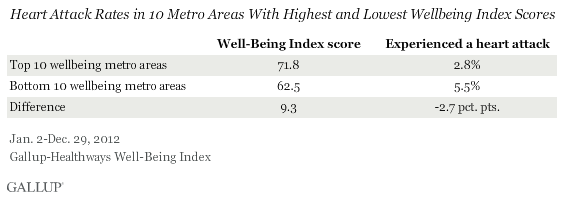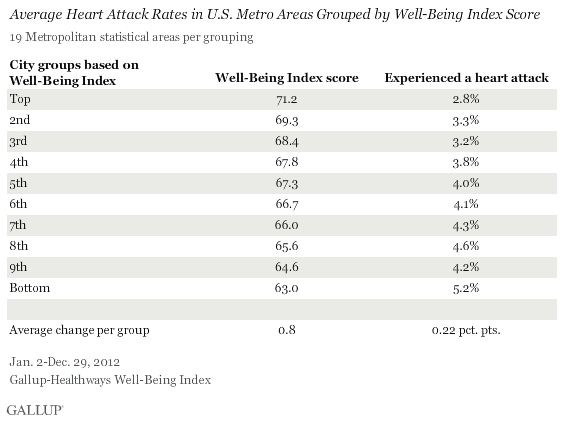WASHINGTON, D.C. -- Americans living in the nation's metropolitan areas with the lowest well-being are about twice as likely to report having a heart attack than are residents living in the metros with the highest well-being. An average of 5.5% of Americans living in the 10 metro areas with the lowest well-being in the U.S. report having had a heart attack, compared with 2.8% of residents in the 10 metro areas with the highest levels of well-being.

These findings are based on an analysis of more than 230,000 interviews across 190 metropolitan areas conducted throughout 2012 with adults aged 18 and older, collected as part of the Gallup-Healthways Well-Being Index.
The metros with the highest Well-Being Index scores in 2012 include Lincoln, Neb.; Boulder, Colo.; and Provo-Orem, Utah. Those with the lowest Well-Being Index scores in 2012 include Charleston, W.Va.; Huntington-Ashland, W.Va.-Ky.-Ohio; and Mobile, Ala. Out of the approximately 3 million adult residents living in the 10 metro areas with the lowest well-being, about 161,000 have experienced a heart attack. If these cities experienced the same rate of heart attacks as what is found in the 10 metro areas with the highest well-being, nearly 80,000 fewer residents would be heart attack victims.
The metro areas this article references are based on the Metropolitan Statistical Areas (MSAs) as defined by the U.S. Office of Management and Budget. In many cases, more than one city is included in the same MSA, and the same MSA can cross state borders. All reported MSAs encompass at least 300 completed surveys, and Gallup has weighted each of these MSA samples to ensure it is demographically representative of that MSA.
The Gallup-Healthways Well-Being Index score is an average of six sub-indexes, which individually examine life evaluation, emotional health, work environment, physical health, healthy behaviors, and access to basic necessities. The overall score and each of the six sub-index scores are calculated on a scale from 0 to 100, where a score of 100 represents the ideal.
To measure the heart attack rate, Gallup asks respondents: "Has a doctor or nurse ever told you that you have had a heart attack?" Nationally, about 4.0% of all adults in 2012 reported having ever experienced a heart attack.
Across Cities, Heart Attack Rates Rise as Well-Being Declines
Sorting the 190 MSAs reported in 2012 into 10 evenly-sized groups based on their Well-Being Index scores reveals that their scores drop by an average of 0.8 points and their heart attack rates climb by an average of 0.22 percentage points in each successive group.
Thus, for every 100,000 adults in any given city, each spot lower on the list of 10 groups represents an estimated additional 220 residents who have experienced a heart attack. And, a city that has a Well-Being Index score that is 1.0 point lower than the next-closest score would expect an estimated 275 additional heart attack victims.

Implications
According to the Centers for Disease Control and Prevention (CDC) about 715,000 Americans have a heart attack each year, about one-quarter of which are repeat incidences. More than 100,000 Americans die from a heart attack annually.
Many of the risk factors for heart attacks are also common characteristics found in metro areas with low well-being, including obesity, high blood pressure, high cholesterol, smoking, having diabetes, and excessive stress. For leaders of these cites, creating a culture of well-being to reduce the chances of heart disease and heart attack among residents of their communities is key. Building such a culture starts with greater awareness and dialogue around well-being, coupled with a combination of involvement by schools, businesses, and local government.
Schools and businesses can help reduce obesity and encourage healthy behaviors by eliminating sugary drinks and foods that are deep-fried or high in sugar, and replacing them with healthier alternatives accompanied by nutritional information. Businesses can give their employees an incentive to maintain a healthy weight by increasing contributions to medical spending accounts when these goals are met.
City governments can invest in widening and lengthening walking/biking paths to encourage pedestrian traffic to grocery stores, schools, and mass transit. They can also encourage restaurants to offer smaller portions and a wide selection of heart-healthy fare as well as promote grocery stores that make it easy for shoppers to find healthy, low-fat foods.
Above all, healthcare, business, education, and government leaders should discuss common goals and ways they can contribute toward improving the health and well-being of residents for the betterment of the entire community.
About the Gallup-Healthways Well-Being Index
The Gallup-Healthways Well-Being Index tracks well-being in the U.S. and provides best-in-class solutions for a healthier world. To learn more, please visit well-beingindex.com.
Survey Methods
Results are based on telephone interviews conducted as part of the Gallup-Healthways Well-Being Index survey Jan. 2-Dec. 29, 2012, with a random sample of 353,563 adults, aged 18 and older, living in all 50 U.S. states and the District of Columbia, selected using random-digit-dial sampling.
The metro areas referenced in this article are based on the Metropolitan Statistical Areas (MSAs) as defined by the U.S. Office of Management and Budget. In many cases, more than one city is included in the same MSA. The San Jose, Calif., metropolitan statistical area, for example, also includes the smaller nearby cities of Sunnyvale and Santa Clara in addition to San Jose itself. Each respondent is attributed to his or her MSA based on the self-report of his or her ZIP code, and all metro areas had at least 300 completed surveys in 2011.
Maximum expected error ranges for the MSAs vary according to size, ranging from less than 1 percentage point for the largest cities represented to ±6.5 percentage points for the smallest cities.
Interviews are conducted with respondents on landline telephones and cellular phones, with interviews conducted in Spanish for respondents who are primarily Spanish-speaking. Each sample includes a minimum quota of 400 cell phone respondents and 600 landline respondents per 1,000 national adults, with additional minimum quotas among landline respondents by region. Landline telephone numbers are chosen at random among listed telephone numbers. Cell phone numbers are selected using random-digit-dial methods. Landline respondents are chosen at random within each household on the basis of which member had the most recent birthday.
Samples are weighted by gender, age, race, Hispanic ethnicity, education, region, adults in the household, and phone status (cell phone only/landline only/both, cell phone mostly, and having an unlisted landline number). Demographic weighting targets are based on the March 2011 Current Population Survey figures for the aged 18 and older non-institutionalized population (through November 30 and all aged 18 and older beginning in December), living in U.S. telephone households. All reported margins of sampling error include the computed design effects for weighting and sample design.
In addition to sampling error, question wording and practical difficulties in conducting surveys can introduce error or bias into the findings of public opinion polls.
For more details on Gallup's polling methodology, visit www.gallup.com.
